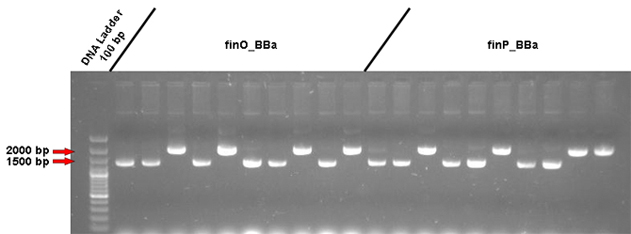Back to Calendar
ColiGuard
F plasmid's cultures miniprep
The cultures grew well and were used to perform the miniprep for F plasmid's extraction, according to Protocol 2.
The resulting product of the performed miniprep was applied to an 0,8% agarose gel to verify if it went well. Two bands showed up in the gel, with the largest appearing to be a 23 kb fragment. The lower molecular weight fragment, showing to be approximately a 21 kb fragment, is the supercoiled F plasmid that results from the miniprep protocol.
The next step is to perform the enzymatic digestion of the extracted F plasmid with the HindIII enzyme.
Gabriel
finO and finP's cultures miniprep
We continued our work with finO and finP today by performing minipreps from yesterday's inoculated cultures, according to Protocol 2.
We had 10 cultures for finO and 10 cultures for finP, in order to assure that at least one of them would have the inserted fragment into it's plasmid.
It's important to highlight that a few samples showed a red coloration this morning. This could only be explained by the religation between the digested vector and it's part (RFP device). Yet we still decided to perform those samples's miniprep, we took note of those samples's numbers.
After this procedure, we ran an agarose gel with all the samples, in order to check miniprep efficiency:

According to the picture, we recovered plasmids on all samples, with considerable amounts of genomic DNA. However, it's not possible to confirm whether those plasmids actually contain our inserts solely by this gel analyses. A PCR procedure must be made.
As we speculated early, each sample whose inocula showed the red coloration resulted in a band of higher size (about 2000 bp) compared to those with normal inocula coloration. This prove the religation between the digested vector and it's part (RFP device).
Marcelo
PY Promoter - PY + BBa_J23100 ligation
After the purification of BBa_J23100 from the gel we performed the SAP Dephosphorylation Protocol (Protocol 9) to dephosphorylate the 5'-ends of the digested plasmid. It is necessary because the restriction enzymes XbaI and SpeI produces compatible cohesive ends, so the plasmid digested by this enzymes can religate.
- <p style=”text-align:justify;”>After the dephosphorylation we prepared 2 ligation reactions with PY1 + BBa_J23100 and PY2 + BBa_J23100.
Fabiana and Leonardo
|






|
|
|